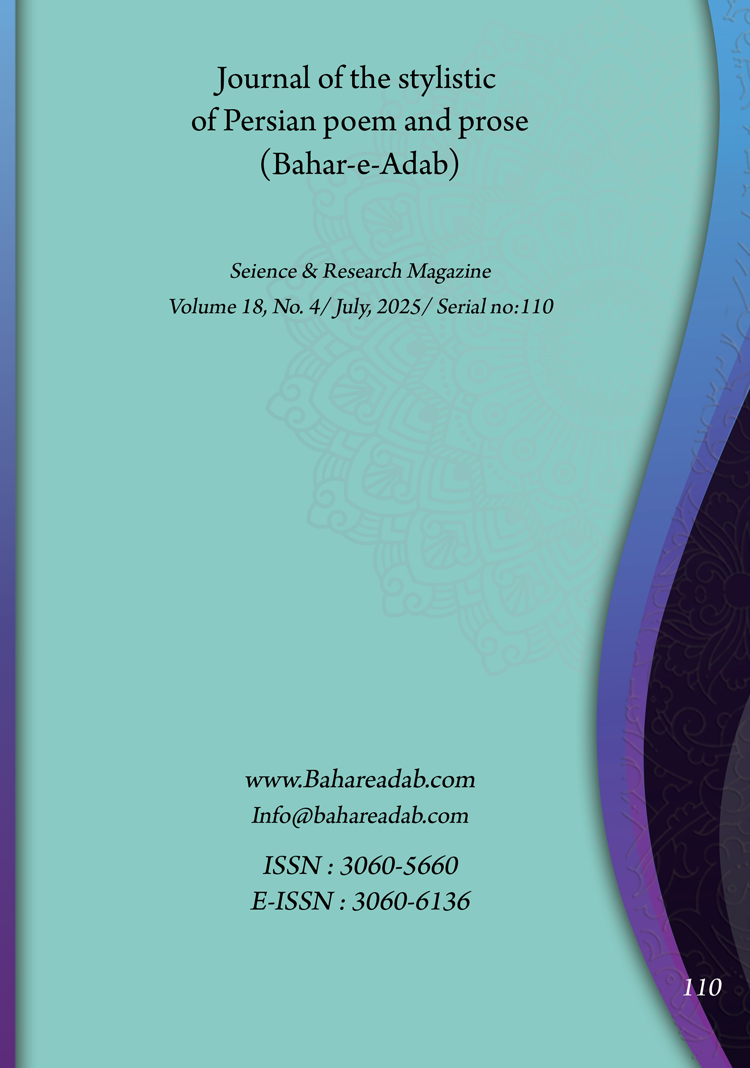- Count View : 83
- آدرس کوتاه شده مقاله: https://bahareadab.com/article_id/1843
- کد doi مقاله: Doi: 10.22034/bahareadab.2025 .18 .7837
Journal of the stylistic of Persian poem and prose
volume Number 18،
number In Volume 4،
،
issue Number 110
Studying the Blending of Lyrical and Epic Literature in Ferdowsi's Shahnameh
Shahin Rashidbeigi , Mehri Talkhabi (Author in Charge), Hossein Arian , Heydar Hassanloo
Abstract
BACKGROUND AND OBJECTIVES: Awareness of the specific characteristics of each literary genre gives the critic or reader a premonition of what literary field he or she is dealing with and determines the horizon of the reader"s expectations from the work. Ferdowsi also displays romantic, philosophical, and mystical themes in Shahnameh by utilizing elements of lyrical poetry. The present study aims to investigate the fusion of lyrical and epic literature in Ferdowsi"s Shahnameh, explaining the examples of lyrical literature in this epic work and its nature.
METHODOLOGY: This study was conducted using a descriptive-analytical method and the necessary information was collected using a library method.
FINDINGS: Lyrical stories in Shahnameh are the result of the connection of love and epic. In fact, in composing epic love stories, the poet"s primary goal was to organize epic narratives, and from an analytical perspective, the issue of lyrical literature comes after the epic. Ferdowsi also refers to philosophical and mystical themes in the conclusion of his epic stories, and a character like Kaykhosro has prominent mystical dimensions in this work. In fact, the movement of Persian poetry from epic to narrative and finally lyrical is a sign of the movement of the taste and spirit of the Iranian people from legend and myth to the description of the reality of inner and social feelings and emotions.
CONCLUSION: By revealing the lyrical features in Shahnameh, it becomes clear that this work is not just an epic, but rather Ferdowsi, by combining epic and lyrical features, has tried to create a work that is as broad as human needs in every time and place. The combination of epic and lyrical in Shahnameh both shows the power and courage of the heroes and the therapeutic and soothing cultural and social aspects that are necessary and essential after the war. These features have turned Shahnameh into a multidimensional work in which various human and cultural aspects are well combined.
Keyword
Shahnameh
, Ferdowsi
, Epic Literature
, Lyrical Literature
, Love
, Literary Type
- Aydenlou, Sajjad. (2009). From Myth to Epic: Seven Discourses in Shahnameh Studies, Mashhad: Jahad Daneshgahi Publications.
- Behravesh, Mohammad Reza. (2019). The Kingdom of Kasra Anushirvan, Tehran: Ayin Tarbiat.
- Borland, C.E. (2019). Myths of Life and Death, translated by Roqayyeh Behzadi, 2nd edition, Tehran: Elm.
- Eslami Nodushan, Mohammad Ali. (2010). The Life and Death of Heroes in Shahnameh, 12th edition, Tehran: Sahami Publication Company.
- Estaji, Ebrahim. (2011). "Structure and Characteristics of Romantic-Epic Stories," Studies in Lyrical Language and Literature, (1) 1, pp. 26-7.
- Hariri, Naser. (2008). Death in Shahnameh (Collection of Articles), Babol: Avishan.
- Khaledi, Hadi and Elhami, Sharare. (2001). "A Study of the Manifestations of Fear in Ferdowsi's Shahnameh", 6th International Conference on Language, Literature, History and Civilization, 6th Session.
- Khorshidi, Nejat’ali, Mansourian, Hossein, and Forsati-Joybari, Reza. (2001). "Characteristics of Epic Death in Shahnameh with Emphasis on the Battle Scenes of the Baysanqari Shahnameh", Islamic Art Studies (46) 18, pp. 99-126.
- Rahiminejad, Bahram. (2009). Golnar and Ardeshir, Tehran: Iran Javan.
- Razmgir, Roshanak. (2022). "Kiani's Princes from Shahnameh to Hafez's Divan", Ormazd Research Journal, Issue 56, pp. 34-45.
- Razmjoo, Hossein. (2003). The Realm of Iranian Epic Literature, Tehran: Institute for Humanities and Cultural Studies.
- Riahi, Mohammad Amin. (2018). Sources of Ferdowsi Studies, 6th edition, Tehran: Institute of Humanities and Cultural Studies.
- Safa, Zabihollah. (1954). Epic Poetry in Iran, Tehran: Amir Kabir.
- Saqebfar, Morteza. (2008). Ferdowsi's Shahnameh and the Philosophy of Iranian History, 2nd edition, Tehran: Ghatre.
- Sarami, Ghadam Ali. (2014). From the Color of the Flower to the Pain of Thorns: Morphology of the Stories of Shahnameh, 6th edition, Tehran: Scientific and Cultural.
- Shafi'i Kadkani, Mohammad Reza. (1973). "Literary Types and Persian Poetry", wise and Effort, No 11 and 12.
- Shamisa, Sirous. (2007). Literary Types, 4th edition, Tehran: Mitra.
- Tadayyon, Mehdi. (2012). "Lyric Poetry and Mysticism," Journal of Studies in Lyrical Language and Literature, No. 4, pp. 41-60.
- Ferdowsi, Abolghasem. (2019). Shahnameh, with the Effort of Jules Mole, Tehran: Mehr Avid.
- Farshidvard, Khosrow. (1984). On Literature and Literary Criticism, Tehran: Tahori.
- Green, Keith and Labihan, Jill. (1997). Textbook of Literary Theory and Criticism, translated by Leila Bahrani Mohammadi and colleagues, Tehran: Rooznegar.
- Malmir, Teymur and Hossein Panahi, Fardin. (1992). “A Structural Study of the Story of Bijan and Manijeh”, Literary Textual Studies, No. 53, pp. 109-132.
- Mahjoub, Mohammad J’afar. (1966). Khorasani Style in Persian Poetry, Tehran: Printing House of the Teacher Training and Educational Research Organization.
- Mousavi, Safieh and Modarresi, Fatemeh. (1998). “Comparison of Two Mystical Characters in Shahnameh and Mohabarata”, Baharestan Sokhan Quarterly, (42) 15, pp. 180-163.
- Vedad, Farhad. (1989). The Mysteries of the Story of Bijan and Manijeh in Ferdowsi's Shahnameh, Tehran: Farhad Vedad Publications.
- Hashemi Esfahani, Mandana. (2006). The Manifestation of Mysticism in the Key Stories of Shahnameh, Tehran: Zovvar.

